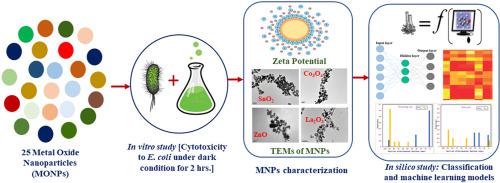Chemosphere ( IF 8.8 ) Pub Date : 2020-09-25 , DOI: 10.1016/j.chemosphere.2020.128428 Supratik Kar , Kavitha Pathakoti , Paul B. Tchounwou , Danuta Leszczynska , Jerzy Leszczynski

|
The toxic effect of eight metal oxide nanoparticles (MONPs) on Escherichia coli was experimentally evaluated following standard bioassay protocols. The obtained cytotoxicity ranking of these studied MONPs is Er2O3, Gd2O3, CeO2, Co2O3, Mn2O3, Co3O4, Fe3O4/WO3 (in descending order). The computed EC50 values from experimental data suggested that Er2O3 and Gd2O3 were the most acutely toxic MONPs to E. coli. To identify the mechanism of toxicity of these 8 MONPs along with 17 other MONPs from our previous study, we employed seven classifications and machine learning (ML) algorithms including linear discriminant analysis (LDA), naïve bayes (NB), multinomial logistic regression (MLogitR), sequential minimal optimization (SMO), AdaBoost, J48, and random forest (RF). We also employed 1st and 2nd generation periodic table descriptors developed by us (without any sophisticated computing facilities) along with experimentally analyzed Zeta-potential, to model the cytotoxicity of these MONPs. Based on qualitative validation metrics, the LDA model appeared to be the best among the 7 tested models. The core environment of metal defined by the ratio of the number of core electrons to the number of valence electrons and the electronegativity count of oxygen showed a positive impact on toxicity. The identified properties were important for understanding the mechanisms of nanotoxicity and for predicting the potential environmental risk associated with MONPs exposure. The developed models can be utilized for environmental risk assessment of any untested MONP to E. coli, thereby providing a scientific basis for the design and preparation of safe nanomaterials.
中文翻译:

评估大量金属氧化物纳米颗粒对大肠杆菌的细胞毒性:通过体外和计算机模拟研究的机理
根据标准生物测定方案,通过实验评估了八个金属氧化物纳米颗粒(MONP)对大肠杆菌的毒性作用。这些研究的MONP的细胞毒性等级为Er 2 O 3,Gd 2 O 3,CeO 2,Co 2 O 3,Mn 2 O 3,Co 3 O 4,Fe 3 O 4 / WO 3(降序)。根据实验数据计算得出的EC 50值表明Er 2 O 3和Gd 2O 3是对大肠杆菌毒性最强的MONPs 。为了确定先前研究中的这8种MONP以及其他17种MONP的毒性机理,我们采用了7种分类和机器学习(ML)算法,包括线性判别分析(LDA),朴素贝叶斯(NB),多项式逻辑回归(MLogitR) ),顺序最小优化(SMO),AdaBoost,J48和随机森林(RF)。我们还聘用了第一名和第二名我们(没有任何先进的计算设备)开发的新一代元素周期表描述符以及经过实验分析的Zeta电位,以模拟这些MONP的细胞毒性。根据定性验证指标,LDA模型似乎是7种测试模型中最好的模型。由核心电子数与价电子数之比和氧的电负性计数定义的金属核心环境对毒性有积极影响。所确定的特性对于理解纳米毒性的机制以及预测与MONP暴露相关的潜在环境风险非常重要。所开发的模型可用于任何未经测试的大肠杆菌MONP的环境风险评估从而为安全纳米材料的设计和制备提供科学依据。



























 京公网安备 11010802027423号
京公网安备 11010802027423号